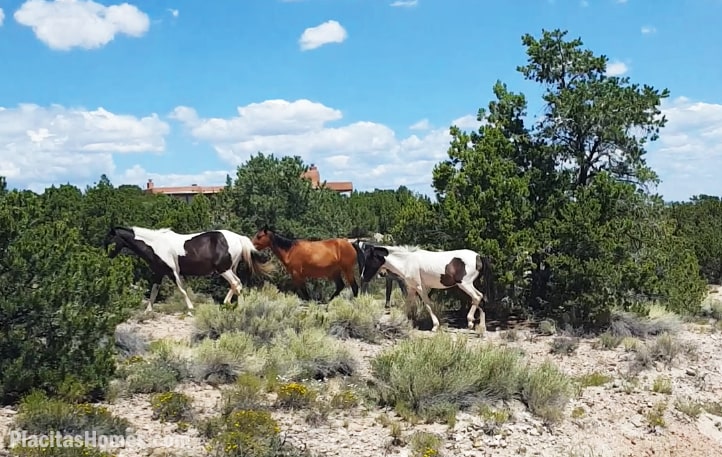Join Our Newsletter
Get the latest Placitas news, real estate market updates and local events. Don’t worry, you can unsubscribe at any time.
Placitas, New Mexico is home to a unique population of wild mustangs that roam the open spaces and mesas of the area. These beautiful wild horses have become a majestic motif of the area and have attracted many visitors over the years. These wild mustangs in Placitas have a unique history, behavior, and face habitual challenges.
Wild horses are an iconic part of the American West, and Placitas is no exception. The mustangs of Placitas lineage derives from horses that were brought to the area by the Spanish conquistadors in the late 16th century.
Over several hundred years, these horses have adapted to the parched climate and mountainous terrain of the region, and have developed particular attributes that set them apart from other wild horses in the country.

The wild horses of Placitas were once a common sight throughout the American West, but today their numbers have dwindled. According to the American Wild Horse Campaign, there are presently less than 100,000 wild horses and burros throughout the entire United States, down from a high of 2 million in the early 1900s. The current population of wild mustangs in Placitas is estimated to be approximately 50 horses.
Wild horses are an iconic part of the American West, and Placitas is no exception. The mustangs of Placitas lineage derives from horses that were brought to the area by the Spanish conquistadors in the late 16th century.

Over several hundred years, these horses have adapted to the parched climate and mountainous terrain of the region, and have developed particular attributes that set them apart from other wild horses in the country.
The wild horses of Placitas were once a common sight throughout the American West, but today their numbers have dwindled. According to the American Wild Horse Campaign, there are presently less than 100,000 wild horses and burros throughout the entire United States, down from a high of 2 million in the early 1900s. The current population of wild mustangs in Placitas is estimated to be approximately 50 horses.
The mustangs of Placitas are known for their hardiness and adaptability. The great news is, they are well adapted to the dry climate of the land, and are able to find water and food in even the bleakest conditions. The horses are also known for their intelligence and independence, and have developed a social structure that is very unique to their population.
One of the most interesting things about the mustangs of Placitas is their coloration. These horses are often referred to as “paints,” because of their striking coat patterns. The wild horses are found in a wide range of colors, from black and white to chestnut and grey, and are also known for their distinctive coat patterns.
American Wild Horse Campaign
Despite their unique characteristics, the wild horses of Placitas face a number of challenges. One of the largest threats to their survival is focused on habitat loss. As more and more land in the American West is developed for residential and commercial use, the mustangs are losing their traditional grazing areas and water sources.
Another challenge facing the mustangs is competition from livestock. Grazing rights on public lands are often awarded to ranchers, who bring their cattle and sheep to graze on the same land that the mustangs depend on. This can lead to overgrazing and resource depletion, making it difficult for the wild horses to find enough food and water to survive.
Finally, the mustangs of Placitas also face threats from human interference. Some people see the horses as a nuisance, and have taken it upon themselves to remove them from the area. This can lead to inhumane treatment of the horses, and can even put their lives at risk.
If you are truly passionate about preserving the mustangs of Placitas, there are several things you can do to help. Here are a few ideas:
Support Local Conservation Efforts. There are a number of organizations in the area that are dedicated to protecting the wild horses of Placitas. Consider making a donation or volunteering your time to support these efforts.
Practice Responsible Tourism. If you plan to visit Placitas, make sure to respect the horses and their habitat. Don’t approach the horses, and don’t feed them or interfere with their natural behavior.
Educate Others About the Mustangs. Many people are not aware of the unique population of wild horses in Placitas, so spreading the word about their existence and the challenges they face can help to raise awareness and support for their preservation.
Advocate for policy change. Contact your local representatives and voice your support for policies that protect wild horses and their habitat. Encourage them to take action to preserve the mustangs of Placitas and other wild horse populations in the United States.
The mustangs of Placitas are a unique and beloved part of the American West. While they face significant challenges, there are things that can be done to help preserve their personal habitat and ensure their survival for future generations to appreciate. By supporting local conservation efforts, practicing responsible tourism, educating others, and advocating for policy change, we can all play a part in protecting these magnificent animals.

Get direct assistance by an experienced and knowledgeable real estate broker in Placitas. You can call, text or e-mail us today.
We are available to help. Call, text or e-mail us today:


Share This Page:
Get the latest Placitas news, real estate market updates and local events. Don’t worry, you can unsubscribe at any time.
All rights reserved.